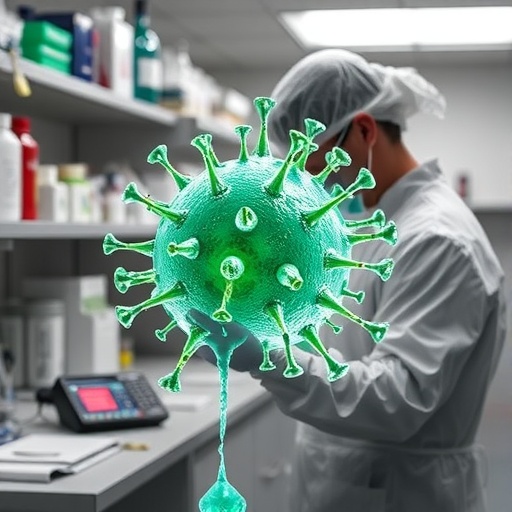Rotavirus remains a formidable global health challenge, particularly threatening infants and young children with severe dehydrating diarrhea. Despite the implementation of widespread vaccination programs that have significantly reduced its impact, rotavirus continues to claim approximately 128,500 lives annually worldwide. Its burden is especially heavy in developing regions where vaccine coverage is inconsistent. However, an alarming trend in the United States — a decline in vaccination uptake — has led to a resurgence in rotavirus cases, signifying the persistent threat this pathogen poses even in well-resourced settings.
Understanding the intricate molecular mechanisms by which rotavirus invades host cells has long been a critical focus area for researchers striving to devise new therapeutic strategies. Now, a breakthrough study from Washington University School of Medicine in St. Louis uncovers a key vulnerability in the virus’s infectious process. This discovery centers on the essential role played by the enzyme fatty acid 2-hydroxylase (FA2H) during the early stages of cellular invasion, a step without which rotavirus fails to establish infection.
Rotavirus initiates infection by traversing the plasma membrane and entering the host cell inside membrane-bound vesicles known as endosomes. Far from being free agents once inside, viral particles initially remain sequestered within these endosomal compartments, necessitating a precise set of molecular events for their escape into the cytoplasm. This stage, commonly referred to as viral uncoating and endosomal escape, is critical for the virus to release its genetic content and replicate effectively.
Through a series of advanced genetic editing techniques, the research team effectively knocked out the FA2H gene in human cell cultures. FA2H, known for its role in lipid metabolism specifically hydroxylating fatty acids at the second carbon position, emerged as an indispensable facilitator of the endosomal escape process. Remarkably, in the absence of FA2H, rotavirus particles were trapped within endosomes, unable to proceed to productive infection cycles, underscoring the enzyme’s pivotal role.
The team extended their investigations to in vivo models by creating genetically engineered mice lacking FA2H specifically in the intestinal epithelial cells lining the small bowel — the primary site of rotavirus infection. These mutant mice exhibited marked resistance to rotavirus-induced disease, displaying significantly diminished symptoms compared to their wild-type counterparts. This animal model validation highlights the therapeutic potential of FA2H inhibition in preventing or mitigating rotavirus infection.
Unlike traditional vaccines, which work primarily by eliciting an immune response to block viral attachment or entry, targeting host factors such as FA2H offers a novel approach. By interfering directly with the host cell machinery that viruses exploit, such strategies may reduce the likelihood of developing drug resistance — a persistent challenge in antiviral drug development. Moreover, the reliance of multiple pathogens on similar cellular entry mechanisms suggests the possibility of broad-spectrum therapeutics.
Indeed, observations from this study reveal that other infectious agents, such as Junín virus — an arenavirus responsible for hemorrhagic fever — and bacterial toxins like Shiga toxin, also depend on the FA2H-mediated pathway for cellular entry and intracellular trafficking. This finding points to the existence of a conserved ‘entry code’ exploited by diverse pathogens, marking FA2H as a central node in the infection networks of multiple disease-causing agents.
In clinical terms, the discovery holds promise for the development of innovative treatment modalities. Drugs designed to mimic the effects of FA2H gene deletion — essentially blocking the enzyme’s function — could serve as host-directed antivirals that thwart infection at its inception. These therapeutics would complement existing vaccination efforts, offering a necessary line of defense for unvaccinated or immunocompromised populations and potentially reducing disease severity.
The implications of this research extend beyond rotavirus alone, setting a precedent for future studies targeting host-pathogen interfaces wherein the host’s molecular machinery is repurposed or hijacked by infectious agents. Target identification such as FA2H exemplifies a shift towards host-centric antiviral strategies that may circumvent some limitations associated with pathogen-targeted drugs, including rapid mutation and evasion.
Siyuan Ding, PhD, an associate professor at WashU Medicine and lead investigator of this study, emphasizes the tragic toll rotavirus exacts on young lives and the urgent need for efficacious treatments. “While vaccines have been transformative, not all children receive them, and rotavirus remains incredibly infectious,” says Ding. “Our approach intervenes within host cells to stop the virus early, providing a complementary strategy alongside vaccination and symptomatic management.”
Published in the Proceedings of the National Academy of Sciences, this research delineates a critical host-virus interaction pathway and introduces FA2H as a linchpin enzyme enabling viral uncoating and release from endosomes. The study employed rigorous experimental methodologies including gene editing, virological assays, and genetically modified animal models, ensuring robustness and translational relevance of the findings.
As research progresses, efforts will focus on screening and developing small molecule inhibitors or other pharmacological agents that can safely suppress FA2H activity in humans without undue side effects. Given the enzyme’s involvement in fundamental lipid metabolism pathways, balancing therapeutic efficacy with safety profiles will be essential for clinical application.
This novel insight into the molecular choreography of rotavirus infection galvanizes the scientific community’s pursuit of host-targeted antiviral therapeutics, drawing a roadmap for combating not only rotavirus but also other pathogens that share the FA2H-dependent entry mechanism. This advance signifies a major stride towards mitigating infectious diseases through innovative approaches grounded in cellular and molecular biology.
Subject of Research: Animals
Article Title: Fatty acid 2-hydroxylase facilitates rotavirus uncoating and endosomal escape
News Publication Date: 3-Sep-2025
Web References: DOI link
References:
Li E, Zang R, Kawagishi T, Zhang W, Iyer K, Hou G, Zeng Q, Meganck RM, Ross SR, Wang X, Su X, Ding S. Fatty acid 2-hydroxylase facilitates rotavirus uncoating and endosomal escape. PNAS. September 3, 2025. DOI: 10.1073/pnas.2511911122
Image Credits: DING LAB
Keywords: Rotavirus, Endosomes, Infectious diseases, Diarrhea, Children
Tags: breakthrough methods in infectious diseaseendosomal transport in viral infectionsfatty acid 2-hydroxylase enzyme researchglobal health impact of rotavirusinfant mortality due to diarrheamolecular mechanisms of viral invasionpediatric health challengesresurgence of rotavirus in the United Statesrotavirus infection prevention strategiestherapeutic strategies for rotavirusvaccination uptake declinevaccine coverage disparities in developing countries





